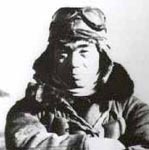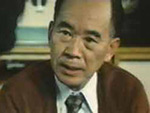Saburo Sakai 坂井 三郎
Pilot A6M2 Zero
Imperial Japanese Navy (IJN) Tainan Kōkūtai
In memory: Saburo Sakai passed away September 22, 2000
|
|
|
|
| Sakai
in flight gear in China |
Sakai signature
and slogan
"Never Give Up" |
Sakai being interviewed in 1976
via Ôzora no samurai (Zero Pilot) |
Sakai in
the 1990's |
Background
Saburo Sakai 坂井 三郎 was born on August 25, 1916 the third-born of four sons and three sisters in Saga, Japan. At age 11, his father died, leaving his mother to raise seven children. Afterwards, Sakai was adopted by his maternal uncle who paid for him to attend Tokyo High School, but did not excel and in his second year returned to Saga.
Wartime History
On May 31, 1933 at age 16, Sakai enlisted in the Imperial Japanese Navy (IJN) as a Sailor Fourth Class (Seaman Recruit) and completed training the next year. In 1935 he assigned to Kirishima as a Sailor Third Class and passed a competitive examination for Naval Gunners' School and was promoted to Sailor Second Class. During 1936, assigned to Haruna as a 14" turret gunner and was promoted to Sailor First Class and Petty Officer Third Class. In 1937, he applied to pilot training at Tsuchiura and graduated first in his class and earned a silver watch from Emperor Hirohito. In 1938 promoted to Petty Officer Second Class.
Although he qualified for aircraft carriers, he was never assigned to one during his combat career.
During the Second Sino-Japanese War,
he flew the A5M Claude in China and was wounded. In October 1939 he claimed a DB-3 shot down before learning to fly the A6M2 Model 21 Zero and was assigned Tainan Kōkūtai.
On December 8, 1941 at the start of the Pacific War took off from Tainan Airfield on a fighter sweep over Clark Field on Luzon in the Philippines and claimed a P-40 Warhawks shot down and two B-17 Flying Fortresses destroyed on the ground. On December 9, 1941 flew missions over Luzon despite bad weather. On December 10, 1941 over Luzon, he participated in the interception of B-17C Flying Fortress 40-2045 piloted by Captain Colin P. Kelly, Jr. that resulted in the shoot down of the bomber.
Guadalcanal Mission
On August 7, 1942
took off piloting an A6M2 Zero from Lakunai Airfield on a mission to escort G4M1 Betty bombers attacking U.S. ships off Tulagi and Guadalcanal. Sakai was leadig the 3rd Chutai, 2nd Shotai with PO2c Enji Kakimoto and Kazushi Uto.
Final Interception
On August 15, 1945 Japan officially surrendered. Afterwards, some Japanese fighter pilots continued to fly interception missions. On August 17, 1945 Sakai took off piloting an A6M5 Zero and intercepted B-32 42-108578 and B-32 42-108532 on a photographic mission over Tokyo and made firing passes.
Later, Sakai commented on the rational for his interception after the official surrender stating: "It may appear that we committed an illegal act. I investigated this matter after the war. What we did was perfectly legal and acceptable under international law and the rules of engagement. While Japan did agree to the surrender, we were still a sovereign nation, and every nation has the right to protect itself. When the Americans sent over their B-32s, we did not know of their intentions... By invading our airspace the were committing a provocative and aggressive act.. It was most unwise for the Americans to send over their bombers only a few days after the surrender announcement! They should have waited and let things cool down."
Confirmed Aerial Victories
F4F Wildcat
5192 pilot Southerland shot down August 7, 1942
Saburo
Sakai Goggles and Helmet
 The flight goggles and flying helmet worn by Sakai on August 7, 1942 are displayed at the National Museum of the Pacific War (Nimitz Museum). On that mission he was
wounded in his eye when bullets three SBDs he attacked from the rear hit his plane. Wounded and flying a damaged fighter, he flew all the way back to Rabaul alone and landed safely. Also a silver belt buckle with a tiger given to Sakai as a good luck gift. When he passed away, he donated these items to the museum. The flight goggles and flying helmet worn by Sakai on August 7, 1942 are displayed at the National Museum of the Pacific War (Nimitz Museum). On that mission he was
wounded in his eye when bullets three SBDs he attacked from the rear hit his plane. Wounded and flying a damaged fighter, he flew all the way back to Rabaul alone and landed safely. Also a silver belt buckle with a tiger given to Sakai as a good luck gift. When he passed away, he donated these items to the museum.
Memorials
Sakai passed away September 22, 2000. He is buried at Sagami Memorial Park in Kamakura, Japan at section C, row 25.
Relatives
Michiko Sakai (daughter)
References
SaburoSakai.com via Wayback Machine April 1, 2004
Ôzora no samurai by Saburo Sakai autobiography
Samurai! (1957) by Saburo Sakai with Martin Caiden and Fred Saito Wildcat
Over Guadalcanal | Lae Aerodrome
April 5, 1942
Ôzora no samurai (movie) (1976) Japanese film based on Sakai's wartime service
Winged Samurai (1985) by Henry Sakaida
Imperial Japanese Naval Aces 1937-45 (1998) by Henry Sakaida pages 26-27 (Ensign Saburo Sakai), 77 (Figure 6, Sakai 1939), 80 (August 17, 1945 interception) 104 (JNAF Aces List - Sakai - 60+), 112 (figure profile no. 6 Sakai)
Aces of the Rising Sun 1937-45 (2000) by Henry Sakaida
Combat Flight Simulator 2 (CFS2) Interview with Saburo Sakai (2000) via Wayback Machine March 6, 2013
Associated Press "Japanese WWII Pilot Defends Military" August 10, 2000
Pacific Ghosts CD-ROM (2002) discovery of F4F Wildcat Sakai shot down August 7, 1942
The Samurai Illustrated Story of the Greatest Zero Pilot (2003) by Masahiro Mino
Eagles of the Southern Sky (2012) by Luca Ruffato, Michael Claringbould and associate editors
FindAGrave -
Saburo Sakai (photos)
First Japanese Mission To Guadalcanal August 7, 1942 (1998) by Michael Claringbould
|




